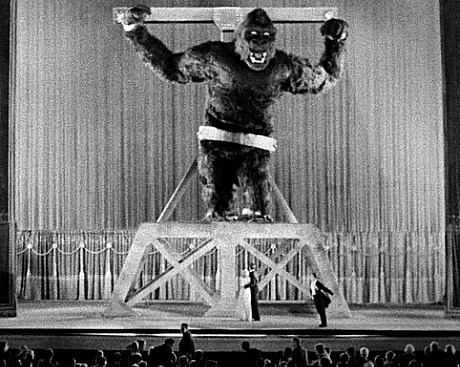I could get all high falutin’ technical in discussing the new King Kong Bluray, but I’m going to boil it down to basics. The disc arrived five or six days ago, and I watched it later that night. Jett, who’s seen King Kong five or six times, walked in and took a look and said, “That’s it? It doesn’t look any different!”

I slightly disagree. I think the Kong Bluray looks a little grainier than the 2005 DVD did. Because Blurays always make grain pop through a bit more than it does via DVD or film itself. Grain becomes feister, livelier. The bottom line is that while the monks are applauding the Kong Bluray and calling it an upgrade in image quality, common-man types don’t see it this way and could even make the argument that it’s a step down because every scene is covered top to bottom with digital mosquitoes.
As Bluray.com’s Kenneth Brown recently explained, its almost the viewer’s fault if there’s any sense of disappointment. Because the viewer should know better going in.
“Beware expectations when approaching King Kong,” he begins. “More to the point, beware uninformed expectations.
“Merian C. Cooper‘s 1933 production is littered with soft photography, spiking grain, murky visual effects sequences and many an imperfect shot, and Warner’s 1080p/VC-1 encoded transfer stays true to each and every frame. Soft edges and textures may dominate the proceedings, but a fair amount of fine detail is apparent throughout, grain is intact, delineation is as revealing as could be expected and object definition is relatively impressive.
“Likewise, black levels are quite deep, mid-range grays are natural and unimpeded, and whites never struck me as stark or ungainly. And the reinstated scenes? The gory bits of chomping, stomping and crushing that were cut in 1938? I didn’t notice any discernible difference in quality. As it turns out, the negative Warner discovered and used for Kong’s restoration featured the full, uncensored cut.
“If anything, thick fields of soupy noise occasionally swamp the presentation (chapter 16 and 17 being the worst of it), but I have no doubt the film’s source, not Warner’s restoration or transfer, is to blame. Some mild artifacting makes an appearance as well, and stands as my lone point of contention. Even then, each instance is so faint and fleeting that it rarely becomes a significant distraction. Ultimately, I would suggest arming yourself with appropriate expectations. Those who do will find Warner’s presentation to be a real treat.”
